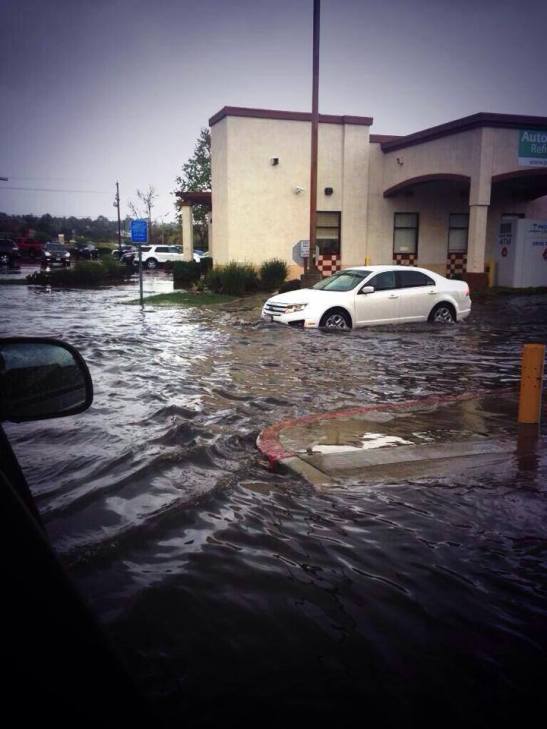Temecula Grapevine
Your source for Temecula, CA and Southwest Riverside County lifestyle, events, & area information
Turn Around Don’t Drown -Riverside County Fire Department offers these words of warning on flood heavy Southwest Riverside streets
Chances are, you hunkered down during the brunt of yesterday’s storm–if you were lucky. Others were out in force, witnessing a torrent of water pouring through Southwest Riverside streets, shopping centers, and area residences. Today, the showers are wider scattered, though the rain is expected to pick up again mid-day.
Here are some Flood Safety Tips The City of Temecula forwarded this report from Riverside County Fire Department:
For example, six inches of fast-moving flood water can knock you off your feet. Whether you are driving or walking, if you come to a flooded road,Turn Around Don’t Drown. You will not know the depth of the water nor will you know the condition of the road under the water.
FLOOD PREVENTION AND PREPAREDNESS TIPS
- Ensure that all drains, gutters and downspouts are functioning properly. This is especially
important for flat-roofed buildings!! - Keep ground-level drains and drainage areas free of debris.
- Move valuable or easily damaged items away from low-lying areas that may be prone to
flooding. - Identify and collect important documents that you may require in case of evacuation.
- Contact your insurance agent to assure that your flood and storm coverage is adequate and in
effect. - Review your Family Emergency Plan and prepare an Emergency Supply Kit
(http://www.ready.gov) that includes food, water, medications, flashlight, battery-powered radio,
rain gear and first aid supplies. - Plan for the needs of pets at home and if you are evacuated.
- Keep your vehicle fueled in case power is cutoff to local fueling stations.
- Identify the safe routes from your home or workplace to high ground.
- Establish out-of-state family contacts so that friends and relatives can determine your location
and status. - If necessary, consult an engineer or licensed contractor to design or build permanent water
and debris control systems for your property. - Landscape slope areas with plants that are fire retardant and suitable for erosion control.
- Keep sandbags, plywood, plastic sheeting, lumber, hand tools and other materials handy for
addressing storm water issues.
TIPS FOR PERSONAL SAFETY DURING A FLOOD
- Avoid the urge to sightsee. Remind all household members not to play or linger near flood
control channels and storm drains. - Do not walk through flowing water. Drowning is the number-one cause of flood deaths,
mostly during flash floods. Currents can be deceptive; six inches of moving water can knock you
off your feet. - Do not drive through a flooded area. More people drown in their car than anywhere else. Do
not drive around road barriers; the road or bridge may be washed out. - Stay away from power lines and electrical wires. The number-two flood killer after drowning
is electrocution. Electrical currents can travel through water.
WHAT SHOULD YOU DO IF YOU FALL IN MOVING WATER?
- Avoid getting into this dangerous situation.
- Remain calm. Don’t waste energy yelling for help after someone has spotted you.
- Get ready to be rescued.
- Try to float on your back with your legs straight and your feet pointed downstream.
- Use your legs to shove yourself away from obstructions.
- Keep your head up so that you can see where you are going.
- Watch for obstacles and debris! If a tree or other stationary object is blocking the channel,
forcing water over it, try to flip over on your stomach and approach the obstacle head-on,
crawling over the top of it. - Most victims in swift water die when they get pinned against obstacles, or get trapped in
submerged debris and vegetation.
WHAT IF YOU SEE SOMEONE FALL INTO MOVING WATER?
- Do not go into the water after the victim.
- Do not try to pull the victim out with your hands, rope, or similar device. Do not attach anything
to yourself and toss it to a victim in the water. The force of the current will pull you in. - If possible, throw a floatation device to the victim, such as a boogie board, styrofoam ice chest,
basketball, or other unattached object. - Immediately call 9-1-1.
- Tell the 9-1-1 operator that someone fell into the channel and is being swept downstream. Say
that swift water rescue teams need to respond. - Give accurate information about where and when you saw the victim and what the victim was
wearing. - Though members of your Riverside County Fire Department and CAL FIRE are specially
trained and equipped to respond to water rescues, not every victim survives. We therefore
remind you that when it comes to swift moving water: ‘Stay Away and Stay Alive!’
FLOOD PREVENTION AND PREPAREDNESS TIPS:
- Ensure that all drains, gutters and downspouts are functioning properly. This is especially
important for flat-roofed buildings!! - Keep ground-level drains and drainage areas free of debris.
- Move valuable or easily damaged items away from low-lying areas that may be prone to
flooding. - Identify and collect important documents that you may require in case of evacuation.
- Contact your insurance agent to assure that your flood and storm coverage is adequate and in
effect. - Review your Family Emergency Plan and prepare an Emergency Supply Kit
(http://www.ready.gov) that includes food, water, medications, flashlight, battery-powered radio,
rain gear and first aid supplies - Plan for the needs of pets at home and if you are evacuated.
- Keep your vehicle fueled in case power is cutoff to local fueling stations.
- Identify the safe routes from your home or workplace to high ground.
- Establish out-of-state family contacts so that friends and relatives can determine your location
and status. - If necessary, consult an engineer or licensed contractor to design or build permanent water
and debris control systems for your property. - Landscape slope areas with plants that are fire retardant and suitable for erosion control.
- Keep sandbags, plywood, plastic sheeting, lumber, hand tools and other materials handy for
addressing storm water issues.
TIPS FOR PERSONAL SAFETY DURING A FLOOD:
- Avoid the urge to sightsee. Remind all household members not to play or linger near flood
control channels and storm drains. - Do not walk through flowing water. Drowning is the number-one cause of flood deaths,
mostly during flash floods. Currents can be deceptive; six inches of moving water can knock you
off your feet. - Do not drive through a flooded area. More people drown in their car than anywhere else. Do
not drive around road barriers; the road or bridge may be washed out. - Stay away from power lines and electrical wires. The number-two flood killer after drowning
is electrocution. Electrical currents can travel through water.
WHAT SHOULD YOU DO IF YOU FALL IN MOVING WATER?
- Avoid getting into this dangerous situation.
- Remain calm. Don’t waste energy yelling for help after someone has spotted you.
- Get ready to be rescued.
- Try to float on your back with your legs straight and your feet pointed downstream.
- Use your legs to shove yourself away from obstructions.
- Keep your head up so that you can see where you are going.
- Watch for obstacles and debris! If a tree or other stationary object is blocking the
channel, forcing water over it, try to flip over on your stomach and approach the obstacle
head-on, crawling over the top of it. - Most victims in swift water die when they get pinned against obstacles, or get trapped
in submerged debris and vegetation.
WHAT IF YOU SEE SOMEONE FALL INTO MOVING WATER?
- Do not go into the water after the victim.
- Do not try to pull the victim out with your hands, rope, or similar device. Do not attach
anything to yourself and toss it to a victim in the water. The force of the current will pull
you in. - If possible, throw a floatation device to the victim, such as a boogie board, styrofoam
ice chest, basketball, or other unattached object. - Immediately call 9-1-1.
- Tell the 9-1-1 operator that someone fell into the channel and is being swept
downstream. Say that swift water rescue teams need to respond. - Give accurate information about where and when you saw the victim and what the
victim was wearing. - Though members of your Riverside County Fire Department and CAL FIRE are
specially trained and equipped to respond to water rescues, not every victim survives.
We therefore remind you that when it comes to swift moving water: ‘Stay Away and Stay Alive!’
WHAT IF YOU NEED SANDBAGS?
In an effort to assist Riverside County residents with extreme storm needs, most Riverside County Fire Stations stock unfilled sandbags in limited quantities. Residents in burned areas have sandbags and sand available at:
- Lakeland Village Station 11 (33020 Maiden Lane)
- Garner Valley Station 53 (59200 Morris Ranch Road)
- Poppet Flats Station 63 (49575 Orchard Road)
If you have eminent or active flooding inside of your residence, dial 9-1-1.
PREPARED? INFORMED?
We recommend these links to help you stay informed and prepared.
NWS: www.weather.gov/nwr
National Weather Service
EDIS: http://edis.oes.ca.gov
Emergency digital information service
CALTRANS: http://www.dot.ca.gov/cgi-bin/roads.cgi
Highway conditions or call 1-800-427-7623
COUNTY ROADS: http://www.rctlma.org/trans/road_main_road_closures.aspx
Riverside County Transportation Department or call 1-951-955-4700
CHP: http://cad.chp.ca.gov/
Traffic incidents/accidents on local highways.
FLOOD CONTROL: http://www.floodcontrol.co.riverside.ca.us
Riverside County flood control
OES: http://www.rvcfire.org/opencms/functions/oes
Riverside County Office of Emergency Services

















go to website order soma online no prescription – soma 350 mg high
LikeLike